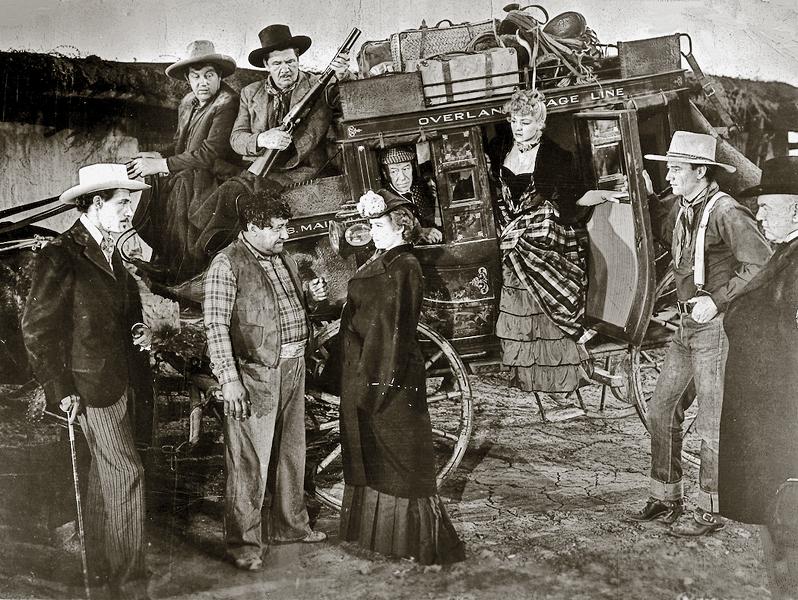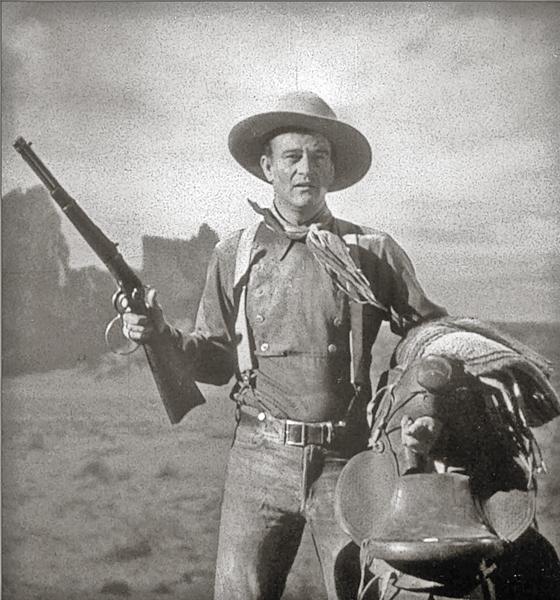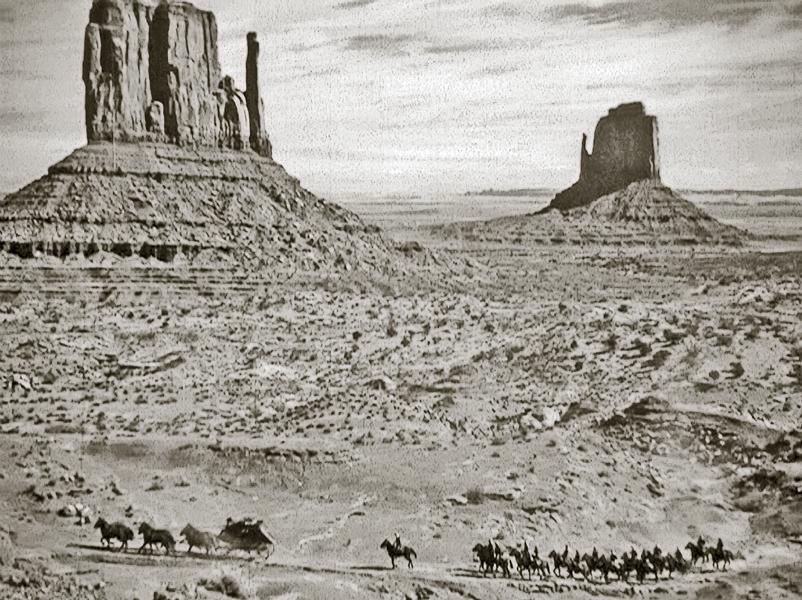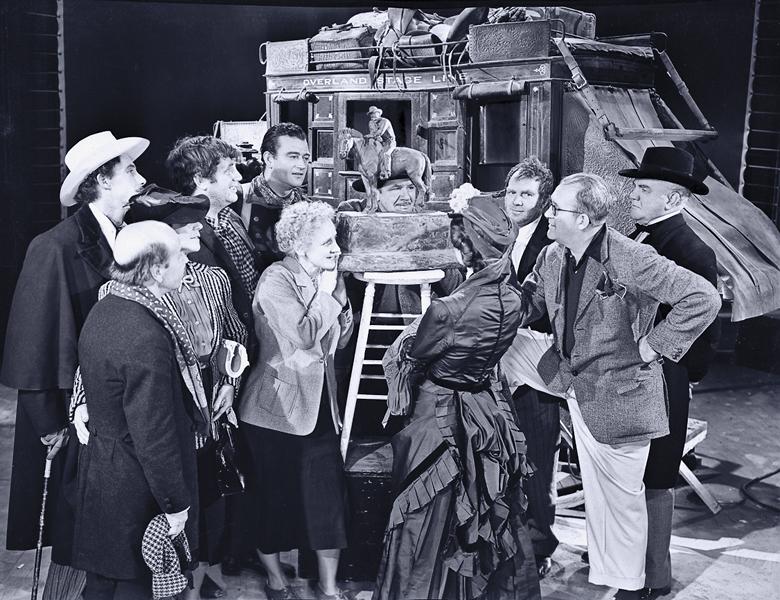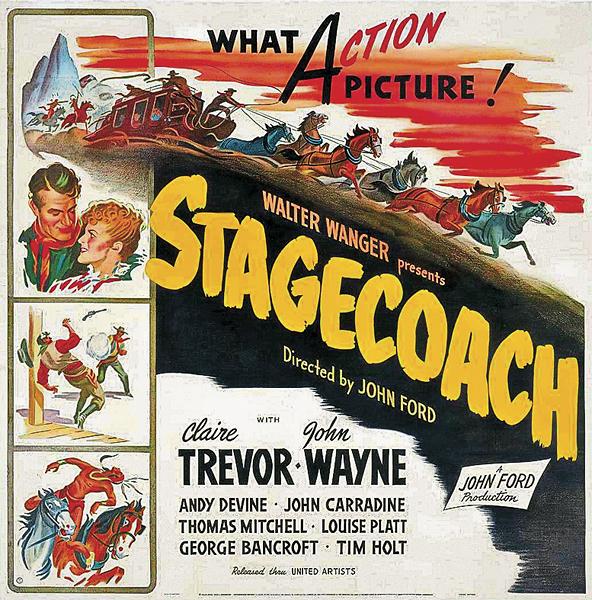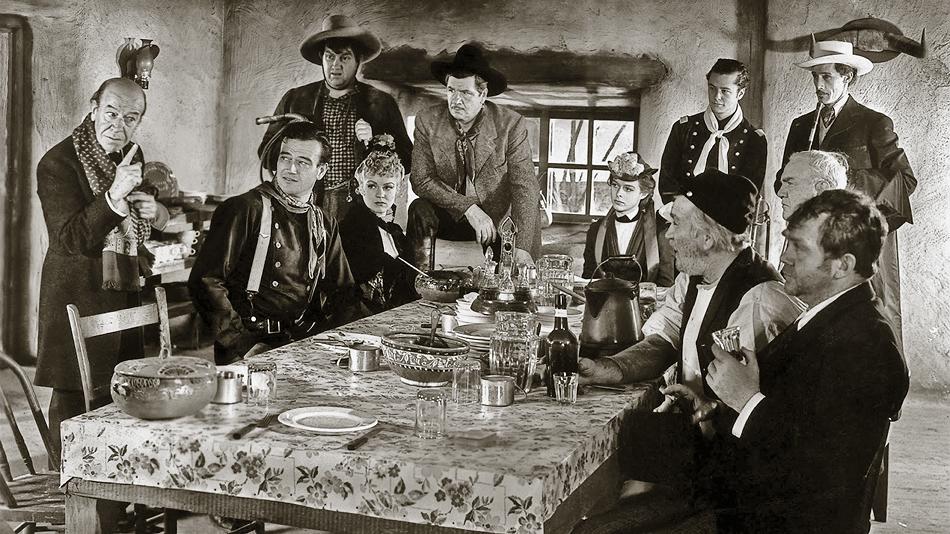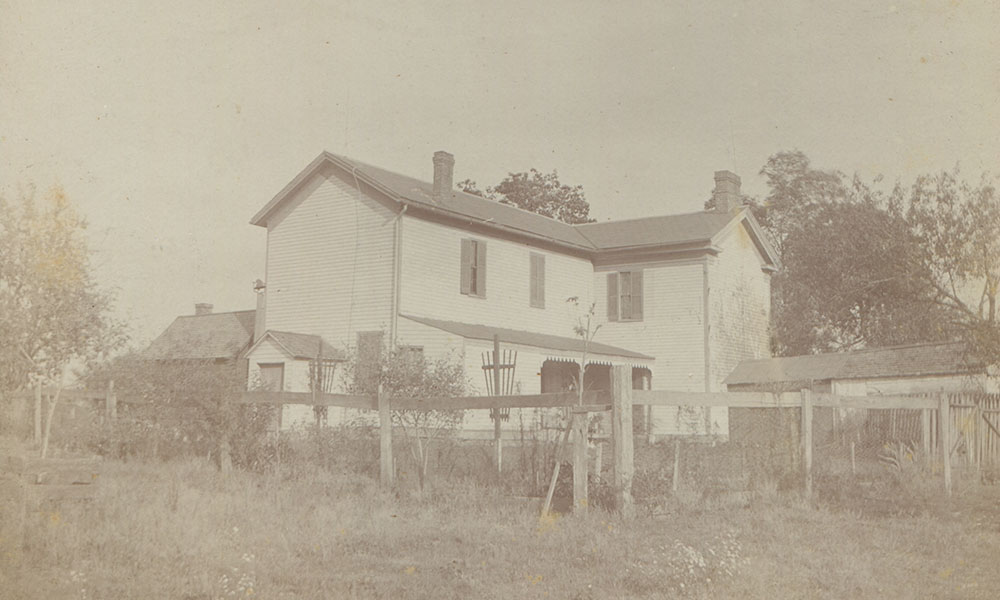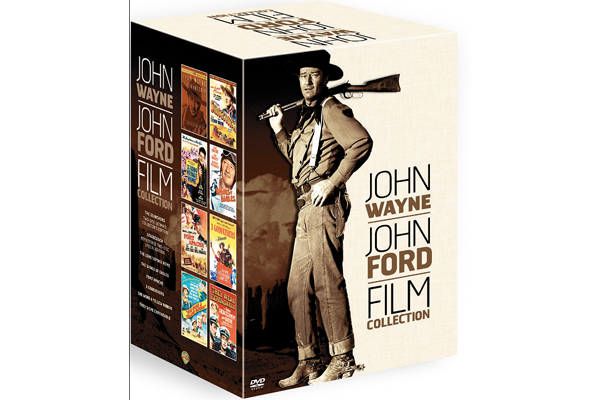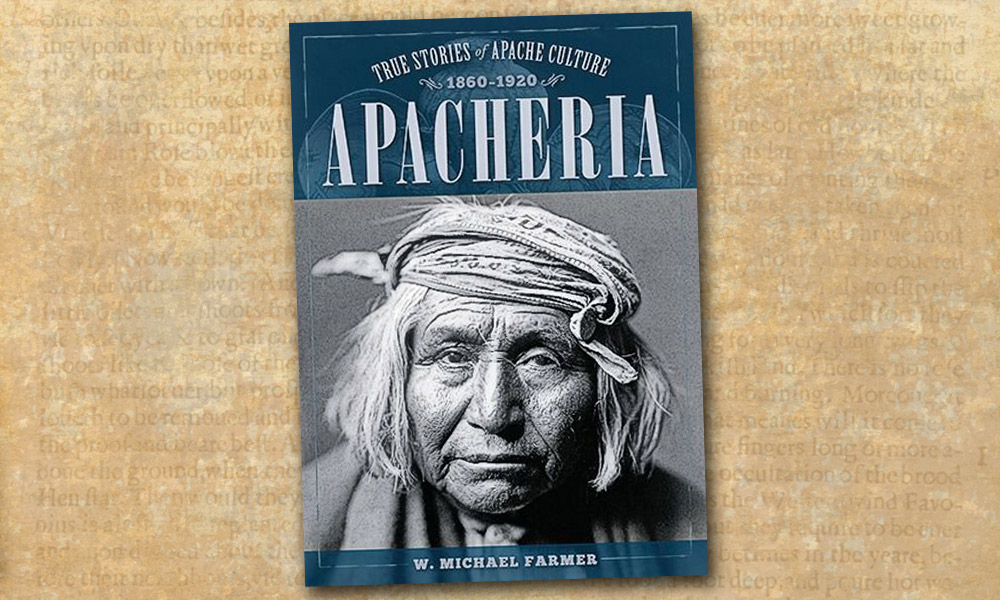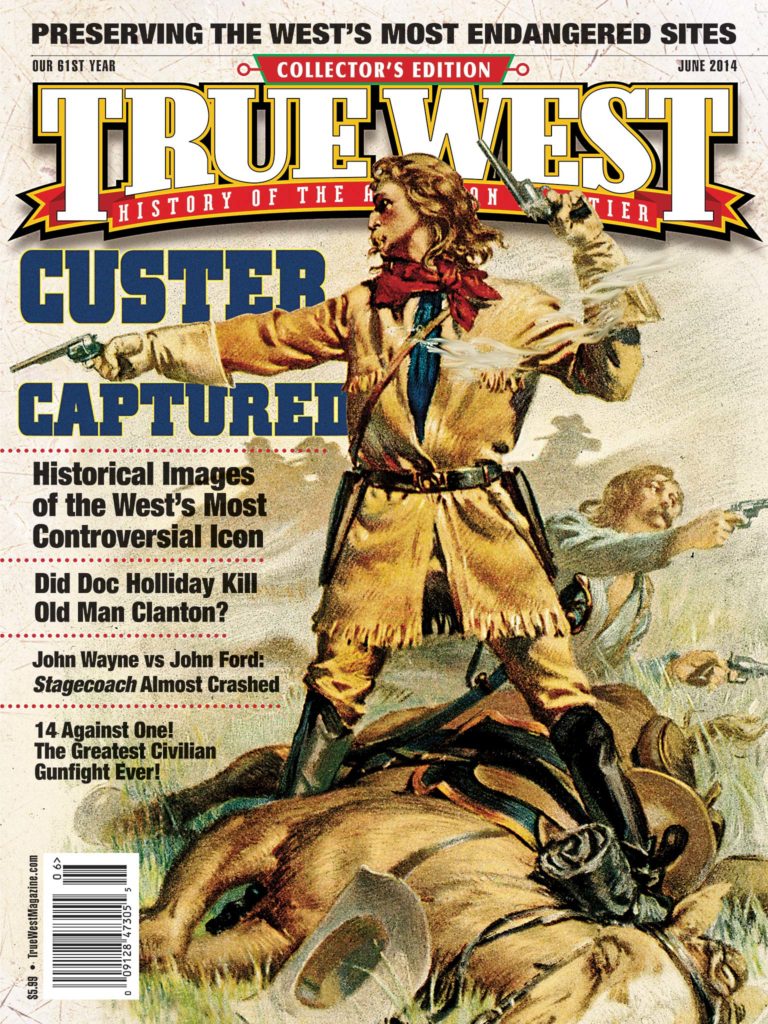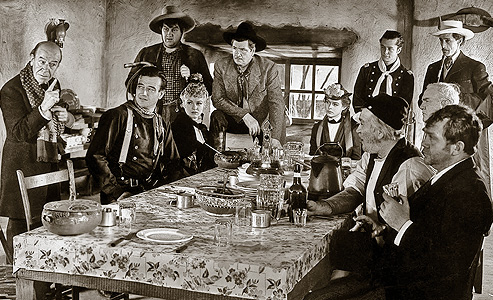 John Wayne had incrementally risen from three-day pictures to six-day pictures to ten-day pictures, with corresponding increases in salary but very little increase in prestige. “I kept nagging at [John] Ford,” remembered Wayne. “‘When is it my turn?’ He’d say, ‘Just wait. I’ll let you know when I get the right script.’ And he did.”
John Wayne had incrementally risen from three-day pictures to six-day pictures to ten-day pictures, with corresponding increases in salary but very little increase in prestige. “I kept nagging at [John] Ford,” remembered Wayne. “‘When is it my turn?’ He’d say, ‘Just wait. I’ll let you know when I get the right script.’ And he did.”
Right after Wayne finished shooting Red River Range, Ford found the script for Wayne. It was Stagecoach.
Ford and his partner Merian C. Cooper first presented their western to David Selznick in June 1937, but Selznick was not enthusiastic about the genre and bridled at featuring downmarket talents like Wayne and Claire Trevor in a Selznick production. He insisted on Gary Cooper and Marlene Dietrich. Ford and Cooper took their project and went home.
Ford nurtured Stagecocach while directing The Hurricane for Sam Goldwyn, and Four Men and a Prayer and Submarine Patrol for Fox. Finally, in the summer of 1938, Stagecoach found a home with producer Walter Wanger, who believed in Ford and in the recurring nature of film cycles. Large-budget westerns had been out of style since the early 1930s and the simultaneous failures of The Big Trail and King Vidor’s Billy the Kid, but Cecil B. DeMille’s The Plainsman had been a big hit in 1936, and Frank Lloyd had made the similarly successful Wells Fargo in 1937.
“It was Ford who worked with Dudley Nichols in creating a fine script; and John Wayne as the Ringo Kid was also Ford’s idea,” said Wanger. On October 31, 1938, Ford started shooting his movie.
In the years to come, Stagecoach would become known almost as much for its locations as for its star. Unless you’d seen every western since Broncho Billy, you’d never seen locations like this before—a Garden of the Gods called Monument Valley.
There’s not a lot of footage of the valley in Stagecoach—the crew spent no more than four days there—but each shot is majestically composed and emphatically placed, with swelling music behind it. In years to come, the question of who stumbled upon Monument Valley would become a hot if irrelevant topic, proving only that in the movie business, success has a thousand fathers, while failure is the proverbial redheaded stepchild.
Harry Goulding, who had lived in Monument Valley since 1921, said that he traveled to Los Angeles with a batch of professional photographs of the valley, and it was those photos that sold Wanger and Ford on doing the location work there. But Ford told his grandson, Dan, that George O’Brien had seen the valley first and came back raving about it. “Harry Goulding had given him a lot of pictures and I was entranced,” said Ford.
And Wayne would stoutly insist that Monument Valley was his idea. “I was hired as an assistant for a George O’Brien western, called, I believe, Riders of the Purple Sage…. One of my jobs was to get 400 head of cattle into Blue Canyon which was 150 miles from any paved road. A preacher who had a little church on the Hopi reservation agreed to help me gather them. In gathering those cattle, we horse-backed into Monument Valley.”
Wayne’s story is possible, although Monument Valley isn’t featured in the 1930 version of Riders of the Purple Sage—it was shot in Sedona. (Wayne claimed only that the cattle were rounded up in the vicinity.)
Wayne said that he had held back the location for ten years until Ford cast him as the lead in Stagecoach and rhetorically wished he could find a fresh, picturesque area to represent the West. Wayne promptly suggested Monument Valley, to which Ford retorted that Wayne had been hired as an actor, not a director.
“Upon [Ford’s] return from location hunting, I was standing with some of the crew when he approached and said, ‘I have found the most colorful location that can ever be used for a picture.’ Then he looked directly at me and said, ‘Monument Valley.’ And I assure you from that moment on, Jack Ford discovered Monument Valley.”
Wayne was not a slam dunk for the part of the Ringo Kid—Ford may have shot a test of Bruce Cabot as well as Wayne. Claire Trevor remembered that Wayne’s test involved their long scene after the birth of the baby—the primary scene between the two characters. “The idea was that he was very respectful of me. He didn’t know I was a hooker. Ford had us play the scene standing against a fence. At one point, Ford took Duke and shook him.
“‘What are you doing with your mouth?’ Ford asked. ‘Why are you moving your mouth so much? Don’t you know that you don’t act with your mouth in pictures? You act with your eyes!’”
Ford and Walter Wanger had to cut a deal for Wayne’s loan-out from Republic. Ford called Republic, but they weren’t overly interested in accommodating him. “They didn’t want to bust up their schedule,” was the way Wayne remembered it.
Ford asked Walter Wanger to go rattle Herb Yates’s cage. Wanger came back to Ford and said, “I can’t deal with these people. They’re stupid.” After much finagling, Republic let Wanger have Wayne for his pro-rated salary—a little more than $6,000 for six weeks’ work. “They were so stupid that they didn’t realize that they could’ve got $50,000–$60,000 for me [on loan-out],” said Wayne.
Ford wouldn’t have been Ford if he hadn’t indulged in some tormenting of his rookie once he started shooting, even if he’d known the rookie for more than ten years, even if the rookie was a seasoned pro. It was not unlike a fraternity hazing. “Don’t you know how to walk?” Ford yelled. “You’re as clumsy as a hippo. And stop slurring your dialogue and show some expression. You look like a poached egg.”
Wayne had been making movies for a decade, but, as Yakima Canutt said, “He was new to the Big Leagues.” Ford rode him mercilessly, made him completely self-conscious. “I said hold your position before you turn,” Ford growled at Wayne on the set. “Chrissakes, can’t you even walk? Not skip, just walk. Goddamn fairy. Put your feet down like you were a man.”
Behind Wayne’s back, Ford’s attitude was 180 degrees away from the persistently brutal hiding he gave him to his face. “He’ll be the biggest star ever,” he told Wayne’s co-star Louise Platt, “because he is the perfect Everyman.”
Wayne nervously asked Yakima Canutt to run lines with him as he tried to come up with readings that Ford wouldn’t decimate. But no matter what Wayne did, it was wrong. During a scene at a way station, Wayne had to wash his face, and Ford even seized on that for faulty technique. “Cut!” yelled Ford. “For Chrissakes, wash your face! Don’t you ever wash it at home? You’re daubing your face, you’re daubing it!” Ford made Wayne do the shot over and over, until his face was nearly raw from the towel.
Wayne had a volatile temper, but with his Coach, his self-control was absolute. “Shit, I was so fucking mad I wanted to kill him,” remembered Wayne. “And he got the whole cast hating him for doin’ that—until finally even Tim Holt, the young kid, was saying, ‘Goddammit, quit picking on Duke like that.’”
Usually, Ford would bring the hammer down when Wayne was peripheral in a scene; if he had an important moment, Ford left him alone. Wayne would always believe that Ford was doing this to get the other actors—who were all more experienced and far more successful than Wayne—on the young man’s side.
But he was also using shock therapy to snap Wayne out of the easy, uninflected display of masculine charm that had been his stock-in-trade. Ford knew that Wayne would always have that as part of his personality, but if the movie was going to succeed, if Wayne was going to act on a higher level, he was going to have to be able to communicate complexities beyond anything he had ever shown before, and Ford didn’t believe he could do it unless he was spurred.
As for the rest of the cast, Thomas Mitchell was working on staying sober—two years and counting—while John Carradine mostly provoked conversations in which he could lay out the case for Edward de Vere as the true author of Shakespeare’s plays.
After they had been on the picture a few weeks, Ford told Wayne to go look at some of the footage that Otho Lovering had been cutting together. Wayne noticed that Andy Devine, playing the stagecoach driver, had not had his reins outfitted with rubber exercisers—it looked like there was no tension on them. Wayne, an experienced prop man, had told Ford’s prop man to get the rubber bands, but it hadn’t been done and Wayne was irritated.
Wayne came back to the set and Ford asked him what he thought. “Well, it’s just magnificent, coach. I’ve never seen anything like it in my life.”
“How do you like [Thomas] Mitchell?”
“Oh, he’s great!”
“How do you like Claire Trevor?”
“Great!”
“Well, how do you like yourself?”
“Well, hell, I’m playing you, so you know what I’m doing.”
“Well, Jesus, Duke, you’ve looked at the whole goddamn thing, isn’t there one criticism, one constructive criticism, that you can give me? You’re acting like a schoolboy!”
Thus drawn in, Wayne complained about the slack reins, whereupon Ford halted production, brought the electricians down off the light grid, gathered the actors and crew and everybody around the center of the soundstage and said, “Well, I just sent our young star in to see his first effort. And he’s very well satisfied with himself, and with the rest of the cast, but he thinks Andy Devine stinks!”
In varying degrees, Ford would indulge in these hazing rituals with unwary or inexperienced actors for the rest of his life. It wasn’t personal; it was the way he told you he liked you. (If he didn’t like you, he completely ignored you.) Beyond that, Ford’s technique of handling actors was to keep them off balance, the better to be able to maintain unquestioned control of the production. For the next quarter century, Ford never really altered his method of handling Wayne: impatience and occasional abuse on the set, open affection off the set.
Dudley Nichols’s screenplay is a model of concision and screen storytelling, and it works off the deeply Fordian premise that Americans reveal their true and, mostly, their best selves under pressure. The characters are all types, but they’re deep, original types—at least for 1939. Each of them is written and played as a layered human being; only the banker Gatewood is no more than the sum of his selfishness, with dialogue that could be transposed directly to Fox News: “Government must not interfere with business. Reduce taxes! The national debt is something terrible!”
For all of Ford’s professed exasperation toward his supposedly feckless protégé, he takes impeccable care of him. The Ringo Kid is sincere, without cant or hypocrisy, the moral center of the film as well as of the little community on the stagecoach. Much of Ford’s artistry consists of his measured, carefully composed handling of the scenes within the cramped confines of the stagecoach, with predominantly triangular compositions that always make Ringo’s silent reactions a cue for our own.
Wayne is far less reactive in Stagecoach than he was in most of his B westerns; Ford’s scripts didn’t require semaphoric acting, because he could communicate plot and dramatic tension visually, without undue emphases from his players. Ford knew that if the script and direction are finely tuned, an actor rarely has to act that much—the audience will project their own emotions into the space left by the filmmakers.
It’s a film full of big, theatrical actors—Thomas Mitchell, John Carradine—who tamp it down, and not even Barbara Stanwyck could give a better performance than Claire Trevor. Ford shoots the exteriors rapturously, the better to contrast with the tightly focused interiors in the stagecoach.
With Ford and Nichols both functioning at the top of their respective games, Stagecoach becomes more than a piece of movie history; it becomes American history. It’s very nearly a perfect piece of construction and execution; the only obvious dramatic flaw is the extraneous song during the scene of the birth, although Ford even manages to work that into the plot, as listening vaqueros end up stealing the spare horses.
After Stagecoach finished shooting on December 22, 1938, four days over a tight thirty-three-day schedule, Wayne had six weeks off before trooping back to Republic and shooting the last four of his Three Mesquiteer westerns: The Night Riders, Three Texas Steers, Wyoming Outlaw, and New Frontier….
When Stagecoach was released in February 1939, even the critics knew that something special had happened with its star. After noting that the cast lacked “strong marquee names,” Variety relented by saying, “John Wayne, as the outlaw, displays talent hitherto only partially used—a forthright, restrained delivery and an appealing personality which here gets a new impetus.” Kate Cameron in the New York Daily News wrote, “Every part is admirably acted…and John Wayne is so good in the role of the outlaw that one wonders why he has had to wait all this time since The Big Trail for another such opportunity.”
Wayne responded with a full-page ad in the trades to let the movie
community know that he was aware his participation in the movie was something special. It featured a smiling, full-face close-up of him in character. “My sincere thanks to Mr. Wanger and Mr. John Ford for the opportunity of playing the Ringo Kid in Stagecoach.”
…Commercially, Stagecoach was only a modest success, but within the industry, Wayne was suddenly recognized as a viable leading man. Wayne would remember with pleasure a compliment from Robert Montgomery when they were making They Were Expendable six years later.
“Duke,” he said, “when I saw Stagecoach, with all those wonderful actors, I thought of what a horrible shame it was to put a plain, straight guy like you in it. Three years later, when I saw Stagecoach again, I realized you were the best actor in the goddamn picture.”
…With Stagecoach grabbing reviews and earning money, Herb Yates realized that he had a star who had been hiding in plain sight for years…. Yates decided to promote Wayne to Republic’s version of A pictures….
Stagecoach marked the smooth meshing of two monumental constructs. In the 96,000 acres of Monument Valley, John Ford found the ultimate frame for his pictures—sandstone buttes like fists punching through the earth’s crust, as well as delicate architectural spires rising toward the sky—a place of majesty and repose. Monument Valley gave the impression that it is as it has always been—permanent, implacable, sacred. At night, clouds descend and settle over the buttes and pillars like gods visiting their creation.
Ford had found the land he was born to put on the screen, as well as his mature style—meditative, with a symmetrical balance between character and theme.
And in his old pal Duke he had found a man to match the land.
This excerpt is published from John Wayne: The Life and Legend by Scott Eyman. Copyright © 2014 by Scott Eyman. Reprinted by Permission of Simon & Schuster, Inc.
Photo Gallery
– All Stagecoach images courtesy United Artists –


